Importance of Financial Management for Business Performance
VerifiedAdded on 2023/06/15
|14
|2806
|200
AI Summary
This report discusses the concept and importance of financial management for businesses. It explains financial statements and ratios used in financial management. It also explores processes that businesses can use to improve their financial performance. The report is relevant to BSc (Hons) Business Management with Foundation BMP3005 Applied Business Finance.
Contribute Materials
Your contribution can guide someone’s learning journey. Share your
documents today.
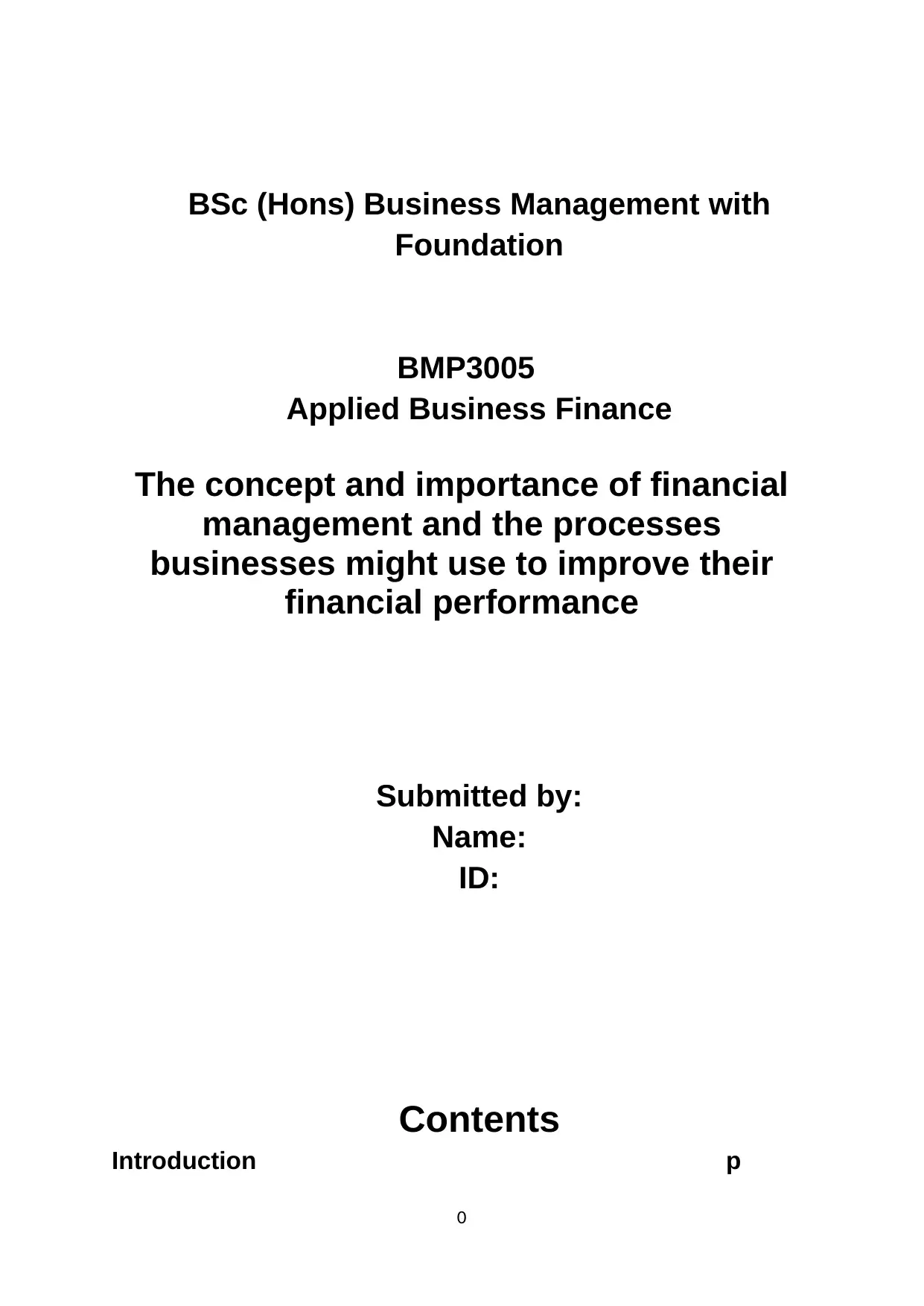
BSc (Hons) Business Management with
Foundation
BMP3005
Applied Business Finance
The concept and importance of financial
management and the processes
businesses might use to improve their
financial performance
Submitted by:
Name:
ID:
Contents
Introduction p
0
Foundation
BMP3005
Applied Business Finance
The concept and importance of financial
management and the processes
businesses might use to improve their
financial performance
Submitted by:
Name:
ID:
Contents
Introduction p
0
Secure Best Marks with AI Grader
Need help grading? Try our AI Grader for instant feedback on your assignments.
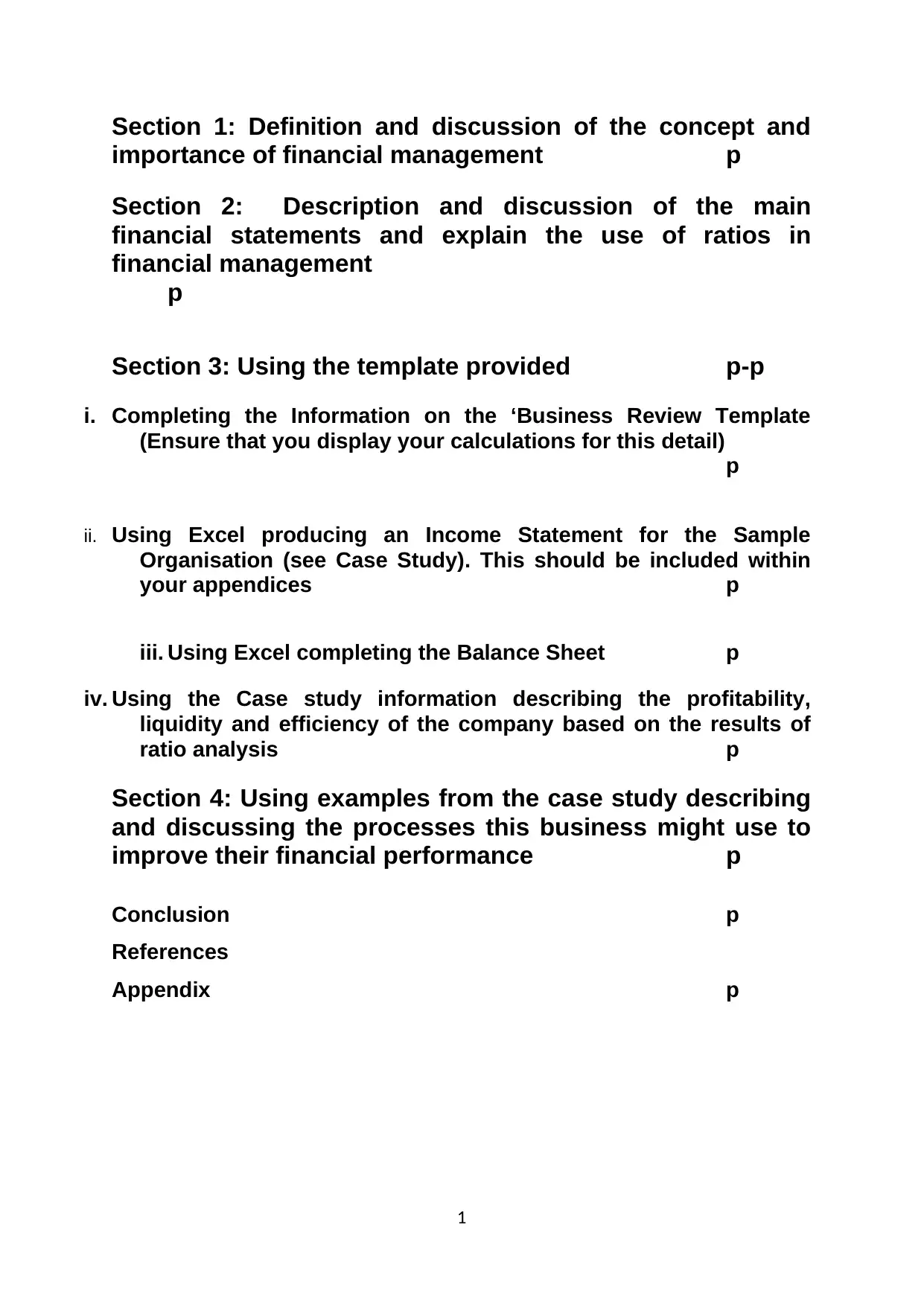
Section 1: Definition and discussion of the concept and
importance of financial management p
Section 2: Description and discussion of the main
financial statements and explain the use of ratios in
financial management
p
Section 3: Using the template provided p-p
i. Completing the Information on the ‘Business Review Template
(Ensure that you display your calculations for this detail)
p
ii. Using Excel producing an Income Statement for the Sample
Organisation (see Case Study). This should be included within
your appendices p
iii. Using Excel completing the Balance Sheet p
iv. Using the Case study information describing the profitability,
liquidity and efficiency of the company based on the results of
ratio analysis p
Section 4: Using examples from the case study describing
and discussing the processes this business might use to
improve their financial performance p
Conclusion p
References
Appendix p
1
importance of financial management p
Section 2: Description and discussion of the main
financial statements and explain the use of ratios in
financial management
p
Section 3: Using the template provided p-p
i. Completing the Information on the ‘Business Review Template
(Ensure that you display your calculations for this detail)
p
ii. Using Excel producing an Income Statement for the Sample
Organisation (see Case Study). This should be included within
your appendices p
iii. Using Excel completing the Balance Sheet p
iv. Using the Case study information describing the profitability,
liquidity and efficiency of the company based on the results of
ratio analysis p
Section 4: Using examples from the case study describing
and discussing the processes this business might use to
improve their financial performance p
Conclusion p
References
Appendix p
1
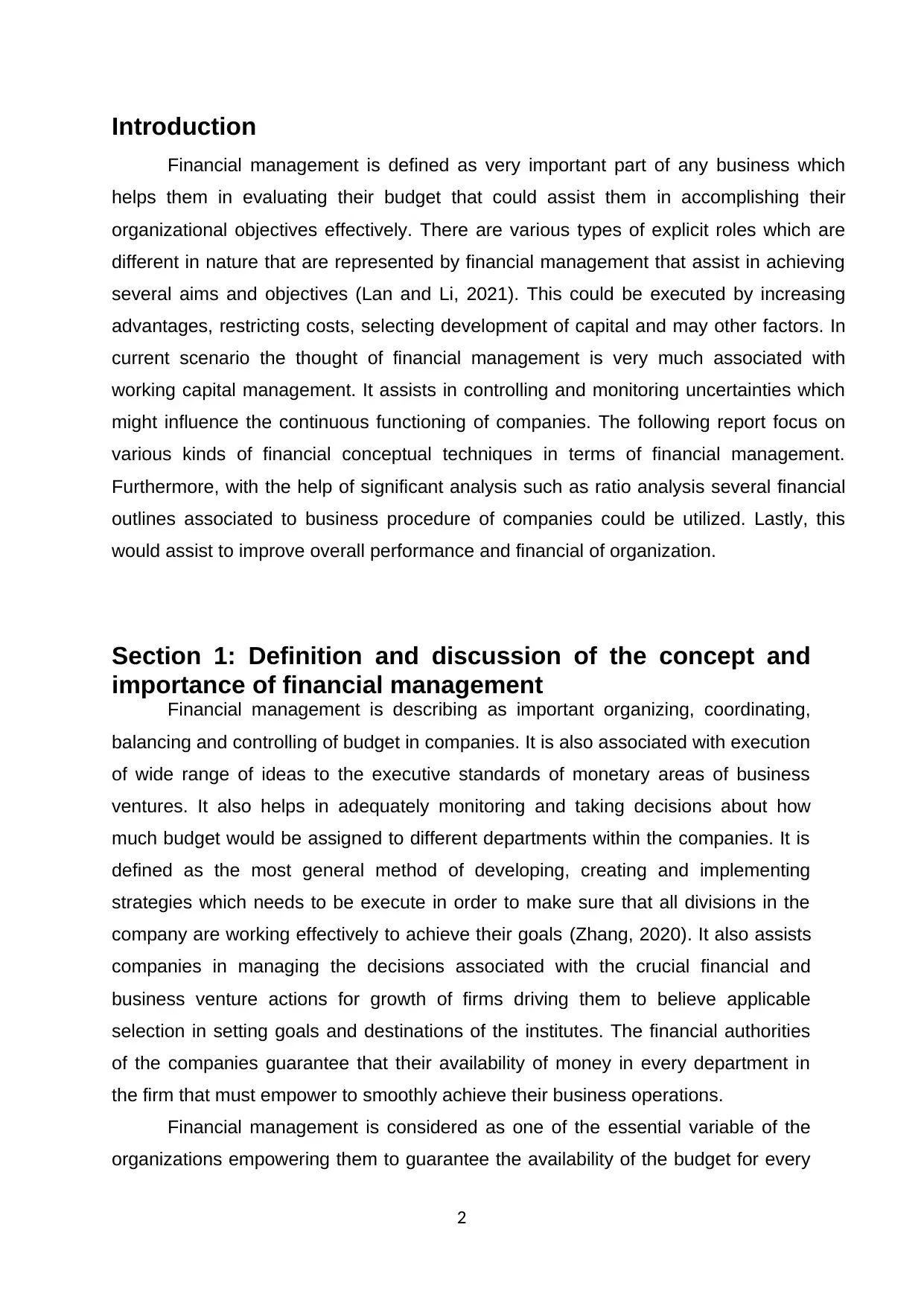
Introduction
Financial management is defined as very important part of any business which
helps them in evaluating their budget that could assist them in accomplishing their
organizational objectives effectively. There are various types of explicit roles which are
different in nature that are represented by financial management that assist in achieving
several aims and objectives (Lan and Li, 2021). This could be executed by increasing
advantages, restricting costs, selecting development of capital and may other factors. In
current scenario the thought of financial management is very much associated with
working capital management. It assists in controlling and monitoring uncertainties which
might influence the continuous functioning of companies. The following report focus on
various kinds of financial conceptual techniques in terms of financial management.
Furthermore, with the help of significant analysis such as ratio analysis several financial
outlines associated to business procedure of companies could be utilized. Lastly, this
would assist to improve overall performance and financial of organization.
Section 1: Definition and discussion of the concept and
importance of financial management
Financial management is describing as important organizing, coordinating,
balancing and controlling of budget in companies. It is also associated with execution
of wide range of ideas to the executive standards of monetary areas of business
ventures. It also helps in adequately monitoring and taking decisions about how
much budget would be assigned to different departments within the companies. It is
defined as the most general method of developing, creating and implementing
strategies which needs to be execute in order to make sure that all divisions in the
company are working effectively to achieve their goals (Zhang, 2020). It also assists
companies in managing the decisions associated with the crucial financial and
business venture actions for growth of firms driving them to believe applicable
selection in setting goals and destinations of the institutes. The financial authorities
of the companies guarantee that their availability of money in every department in
the firm that must empower to smoothly achieve their business operations.
Financial management is considered as one of the essential variable of the
organizations empowering them to guarantee the availability of the budget for every
2
Financial management is defined as very important part of any business which
helps them in evaluating their budget that could assist them in accomplishing their
organizational objectives effectively. There are various types of explicit roles which are
different in nature that are represented by financial management that assist in achieving
several aims and objectives (Lan and Li, 2021). This could be executed by increasing
advantages, restricting costs, selecting development of capital and may other factors. In
current scenario the thought of financial management is very much associated with
working capital management. It assists in controlling and monitoring uncertainties which
might influence the continuous functioning of companies. The following report focus on
various kinds of financial conceptual techniques in terms of financial management.
Furthermore, with the help of significant analysis such as ratio analysis several financial
outlines associated to business procedure of companies could be utilized. Lastly, this
would assist to improve overall performance and financial of organization.
Section 1: Definition and discussion of the concept and
importance of financial management
Financial management is describing as important organizing, coordinating,
balancing and controlling of budget in companies. It is also associated with execution
of wide range of ideas to the executive standards of monetary areas of business
ventures. It also helps in adequately monitoring and taking decisions about how
much budget would be assigned to different departments within the companies. It is
defined as the most general method of developing, creating and implementing
strategies which needs to be execute in order to make sure that all divisions in the
company are working effectively to achieve their goals (Zhang, 2020). It also assists
companies in managing the decisions associated with the crucial financial and
business venture actions for growth of firms driving them to believe applicable
selection in setting goals and destinations of the institutes. The financial authorities
of the companies guarantee that their availability of money in every department in
the firm that must empower to smoothly achieve their business operations.
Financial management is considered as one of the essential variable of the
organizations empowering them to guarantee the availability of the budget for every
2

division within firm. This will help the organization in guaranteeing the effective and
smooth supply of finances so that necessary assets could be obtained successfully
as well as proficiently. The proper implementation of financial management aid
companies in providing strong financial position through organizing the finances
effectively and successfully allocating the resources in every single department of
the firms empowering them to enhance their performance (Xu, 2019). Furthermore, it
also assists the finance manager to take all responsibility associated with financial
decisions which are adequately incorporated with aims of business.
Section 2: Description and discussion of the main
financial statements and explain the use of ratios in
financial management
Financial statements are described as the written summary of overall financial
transactions and budget allocated of companies. It assists in providing effective
growth to organizations and enhance their performance through evaluating financial
status. These financial statements are generally examined by various external
parties such as tax officials, government authorities, auditors and many more to
supervise the financial situation of organizations (Veledar and Letica, 2020). The
various kinds of financial statements which includes Balance Sheet, income
statements and cash flow that are described below in detail:
Balance sheet: This factor is related to financial summaries which are
arranged by companies that involves all kinds of liabilities and assets. It also
contains the investors value that empowers to take decisions regarding
financial situation of companies.
Equation: Assets= ( Liabilities + Owner's Fund )
Income statement: This is defined as another form of budget summary of
companies that mainly involves income statements, expenditures which are
mainly created from business operations (Liu, 2020). It also assists in
deciding the level of productivity that companies could achieve during a
particular financial year. It helps in evaluating overall pay, cost, incomes and
profit on shares critically.
Equation: Net Income=( Revenue - Expenses )
3
smooth supply of finances so that necessary assets could be obtained successfully
as well as proficiently. The proper implementation of financial management aid
companies in providing strong financial position through organizing the finances
effectively and successfully allocating the resources in every single department of
the firms empowering them to enhance their performance (Xu, 2019). Furthermore, it
also assists the finance manager to take all responsibility associated with financial
decisions which are adequately incorporated with aims of business.
Section 2: Description and discussion of the main
financial statements and explain the use of ratios in
financial management
Financial statements are described as the written summary of overall financial
transactions and budget allocated of companies. It assists in providing effective
growth to organizations and enhance their performance through evaluating financial
status. These financial statements are generally examined by various external
parties such as tax officials, government authorities, auditors and many more to
supervise the financial situation of organizations (Veledar and Letica, 2020). The
various kinds of financial statements which includes Balance Sheet, income
statements and cash flow that are described below in detail:
Balance sheet: This factor is related to financial summaries which are
arranged by companies that involves all kinds of liabilities and assets. It also
contains the investors value that empowers to take decisions regarding
financial situation of companies.
Equation: Assets= ( Liabilities + Owner's Fund )
Income statement: This is defined as another form of budget summary of
companies that mainly involves income statements, expenditures which are
mainly created from business operations (Liu, 2020). It also assists in
deciding the level of productivity that companies could achieve during a
particular financial year. It helps in evaluating overall pay, cost, incomes and
profit on shares critically.
Equation: Net Income=( Revenue - Expenses )
3
Secure Best Marks with AI Grader
Need help grading? Try our AI Grader for instant feedback on your assignments.
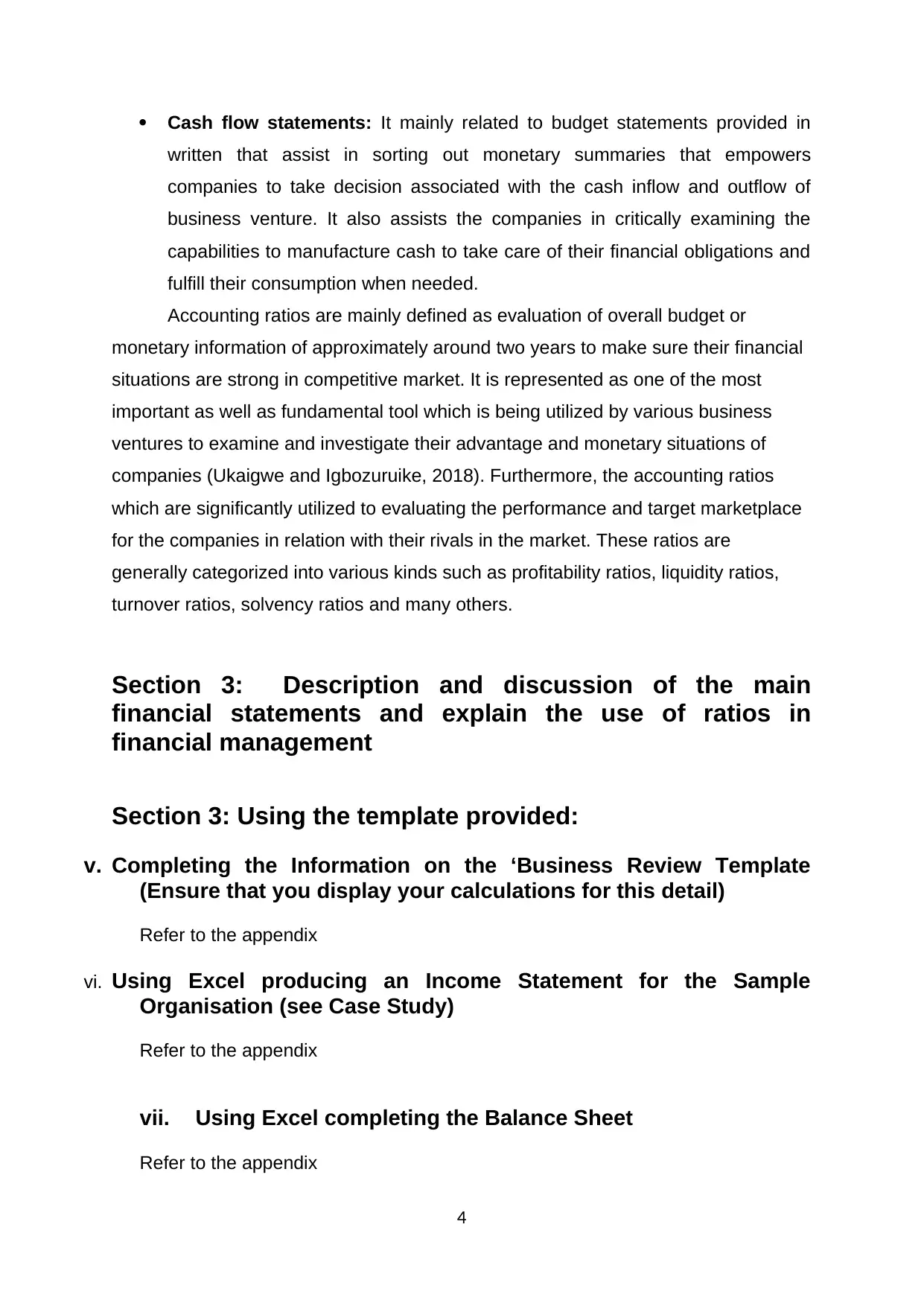
Cash flow statements: It mainly related to budget statements provided in
written that assist in sorting out monetary summaries that empowers
companies to take decision associated with the cash inflow and outflow of
business venture. It also assists the companies in critically examining the
capabilities to manufacture cash to take care of their financial obligations and
fulfill their consumption when needed.
Accounting ratios are mainly defined as evaluation of overall budget or
monetary information of approximately around two years to make sure their financial
situations are strong in competitive market. It is represented as one of the most
important as well as fundamental tool which is being utilized by various business
ventures to examine and investigate their advantage and monetary situations of
companies (Ukaigwe and Igbozuruike, 2018). Furthermore, the accounting ratios
which are significantly utilized to evaluating the performance and target marketplace
for the companies in relation with their rivals in the market. These ratios are
generally categorized into various kinds such as profitability ratios, liquidity ratios,
turnover ratios, solvency ratios and many others.
Section 3: Description and discussion of the main
financial statements and explain the use of ratios in
financial management
Section 3: Using the template provided:
v. Completing the Information on the ‘Business Review Template
(Ensure that you display your calculations for this detail)
Refer to the appendix
vi. Using Excel producing an Income Statement for the Sample
Organisation (see Case Study)
Refer to the appendix
vii. Using Excel completing the Balance Sheet
Refer to the appendix
4
written that assist in sorting out monetary summaries that empowers
companies to take decision associated with the cash inflow and outflow of
business venture. It also assists the companies in critically examining the
capabilities to manufacture cash to take care of their financial obligations and
fulfill their consumption when needed.
Accounting ratios are mainly defined as evaluation of overall budget or
monetary information of approximately around two years to make sure their financial
situations are strong in competitive market. It is represented as one of the most
important as well as fundamental tool which is being utilized by various business
ventures to examine and investigate their advantage and monetary situations of
companies (Ukaigwe and Igbozuruike, 2018). Furthermore, the accounting ratios
which are significantly utilized to evaluating the performance and target marketplace
for the companies in relation with their rivals in the market. These ratios are
generally categorized into various kinds such as profitability ratios, liquidity ratios,
turnover ratios, solvency ratios and many others.
Section 3: Description and discussion of the main
financial statements and explain the use of ratios in
financial management
Section 3: Using the template provided:
v. Completing the Information on the ‘Business Review Template
(Ensure that you display your calculations for this detail)
Refer to the appendix
vi. Using Excel producing an Income Statement for the Sample
Organisation (see Case Study)
Refer to the appendix
vii. Using Excel completing the Balance Sheet
Refer to the appendix
4
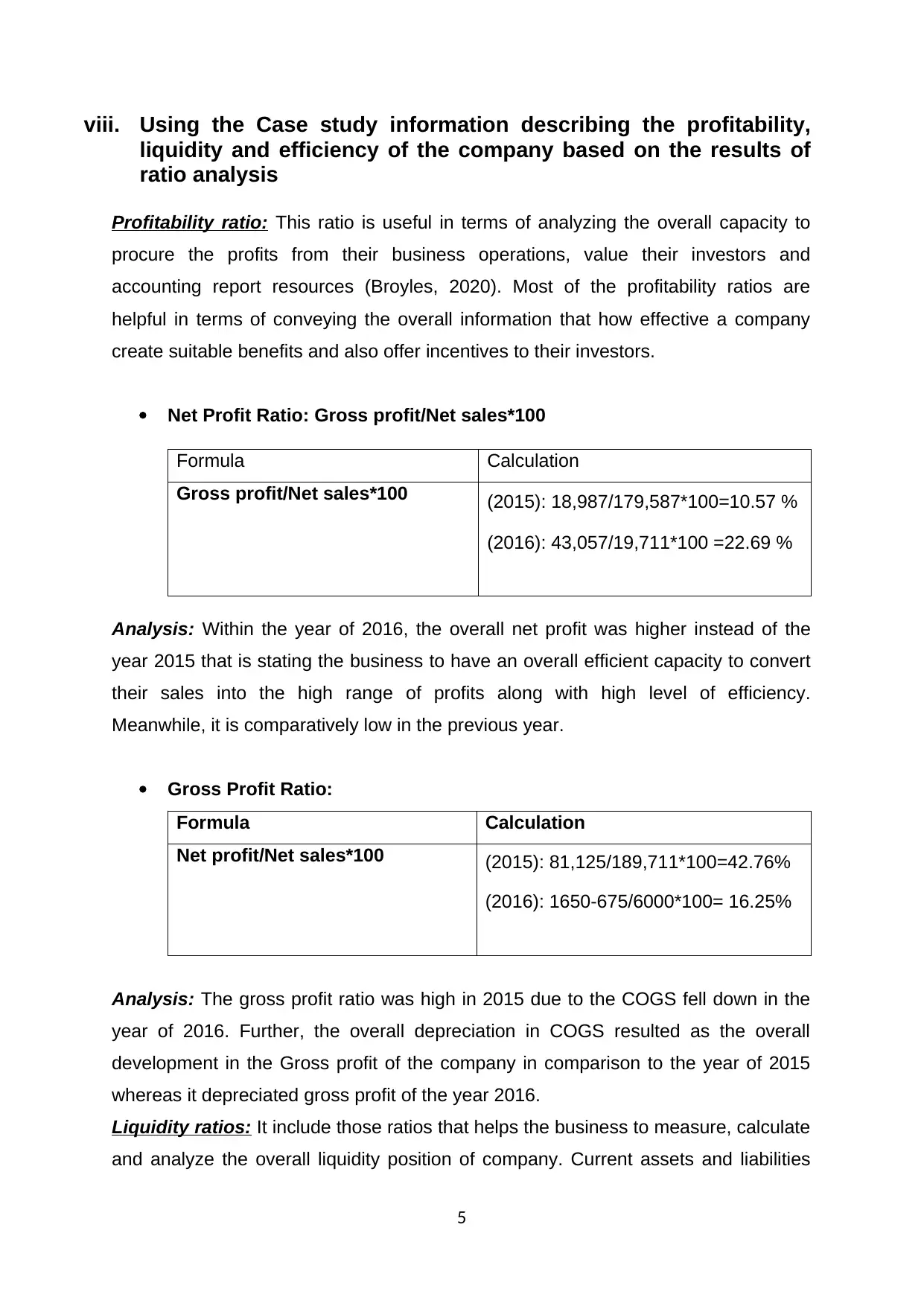
viii. Using the Case study information describing the profitability,
liquidity and efficiency of the company based on the results of
ratio analysis
Profitability ratio: This ratio is useful in terms of analyzing the overall capacity to
procure the profits from their business operations, value their investors and
accounting report resources (Broyles, 2020). Most of the profitability ratios are
helpful in terms of conveying the overall information that how effective a company
create suitable benefits and also offer incentives to their investors.
Net Profit Ratio: Gross profit/Net sales*100
Formula Calculation
Gross profit/Net sales*100 (2015): 18,987/179,587*100=10.57 %
(2016): 43,057/19,711*100 =22.69 %
Analysis: Within the year of 2016, the overall net profit was higher instead of the
year 2015 that is stating the business to have an overall efficient capacity to convert
their sales into the high range of profits along with high level of efficiency.
Meanwhile, it is comparatively low in the previous year.
Gross Profit Ratio:
Formula Calculation
Net profit/Net sales*100 (2015): 81,125/189,711*100=42.76%
(2016): 1650-675/6000*100= 16.25%
Analysis: The gross profit ratio was high in 2015 due to the COGS fell down in the
year of 2016. Further, the overall depreciation in COGS resulted as the overall
development in the Gross profit of the company in comparison to the year of 2015
whereas it depreciated gross profit of the year 2016.
Liquidity ratios: It include those ratios that helps the business to measure, calculate
and analyze the overall liquidity position of company. Current assets and liabilities
5
liquidity and efficiency of the company based on the results of
ratio analysis
Profitability ratio: This ratio is useful in terms of analyzing the overall capacity to
procure the profits from their business operations, value their investors and
accounting report resources (Broyles, 2020). Most of the profitability ratios are
helpful in terms of conveying the overall information that how effective a company
create suitable benefits and also offer incentives to their investors.
Net Profit Ratio: Gross profit/Net sales*100
Formula Calculation
Gross profit/Net sales*100 (2015): 18,987/179,587*100=10.57 %
(2016): 43,057/19,711*100 =22.69 %
Analysis: Within the year of 2016, the overall net profit was higher instead of the
year 2015 that is stating the business to have an overall efficient capacity to convert
their sales into the high range of profits along with high level of efficiency.
Meanwhile, it is comparatively low in the previous year.
Gross Profit Ratio:
Formula Calculation
Net profit/Net sales*100 (2015): 81,125/189,711*100=42.76%
(2016): 1650-675/6000*100= 16.25%
Analysis: The gross profit ratio was high in 2015 due to the COGS fell down in the
year of 2016. Further, the overall depreciation in COGS resulted as the overall
development in the Gross profit of the company in comparison to the year of 2015
whereas it depreciated gross profit of the year 2016.
Liquidity ratios: It include those ratios that helps the business to measure, calculate
and analyze the overall liquidity position of company. Current assets and liabilities
5
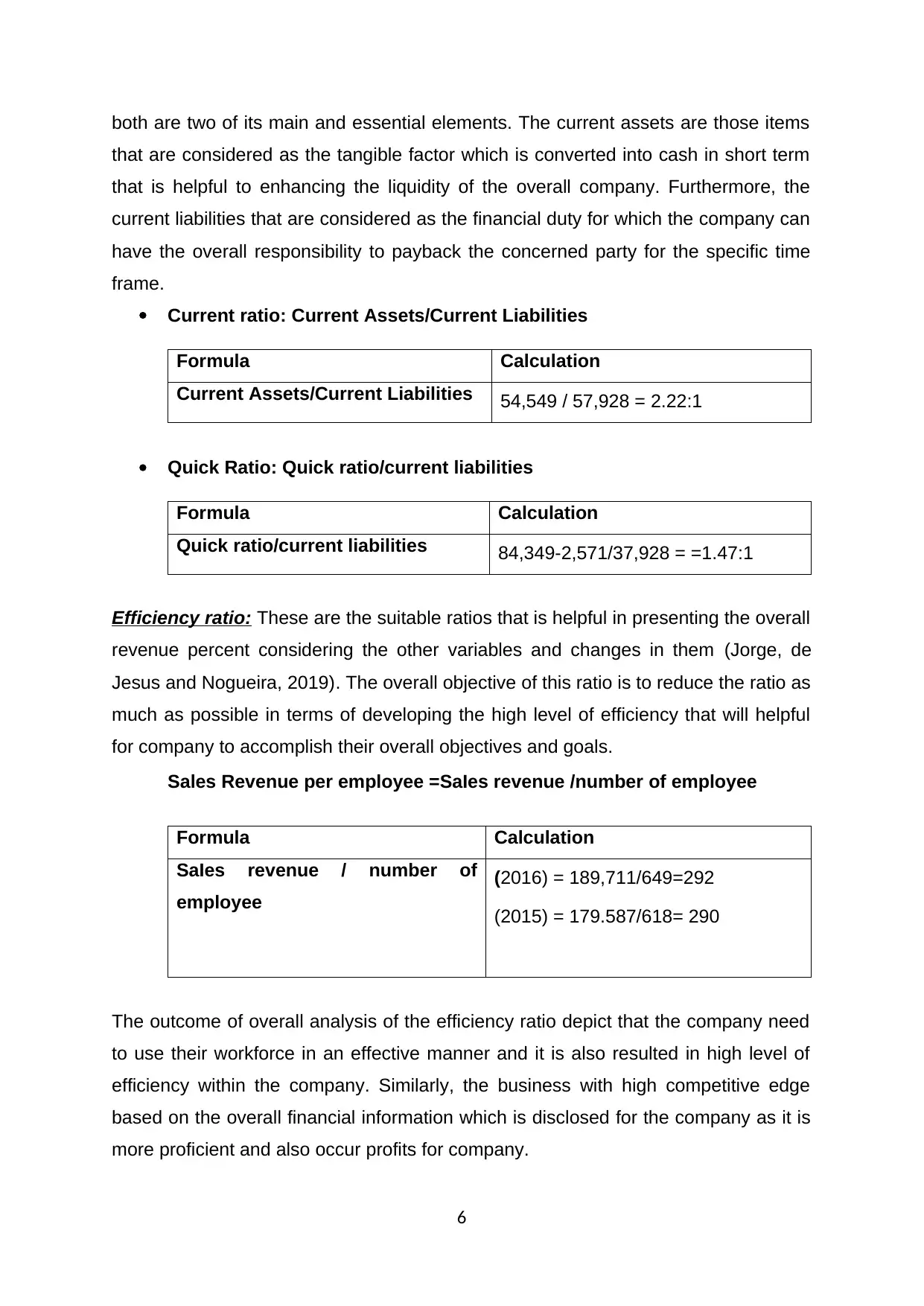
both are two of its main and essential elements. The current assets are those items
that are considered as the tangible factor which is converted into cash in short term
that is helpful to enhancing the liquidity of the overall company. Furthermore, the
current liabilities that are considered as the financial duty for which the company can
have the overall responsibility to payback the concerned party for the specific time
frame.
Current ratio: Current Assets/Current Liabilities
Formula Calculation
Current Assets/Current Liabilities 54,549 / 57,928 = 2.22:1
Quick Ratio: Quick ratio/current liabilities
Formula Calculation
Quick ratio/current liabilities 84,349-2,571/37,928 = =1.47:1
Efficiency ratio: These are the suitable ratios that is helpful in presenting the overall
revenue percent considering the other variables and changes in them (Jorge, de
Jesus and Nogueira, 2019). The overall objective of this ratio is to reduce the ratio as
much as possible in terms of developing the high level of efficiency that will helpful
for company to accomplish their overall objectives and goals.
Sales Revenue per employee =SaIes revenue /number of employee
Formula Calculation
SaIes revenue / number of
employee
(2016) = 189,711/649=292
(2015) = 179.587/618= 290
The outcome of overall analysis of the efficiency ratio depict that the company need
to use their workforce in an effective manner and it is also resulted in high level of
efficiency within the company. Similarly, the business with high competitive edge
based on the overall financial information which is disclosed for the company as it is
more proficient and also occur profits for company.
6
that are considered as the tangible factor which is converted into cash in short term
that is helpful to enhancing the liquidity of the overall company. Furthermore, the
current liabilities that are considered as the financial duty for which the company can
have the overall responsibility to payback the concerned party for the specific time
frame.
Current ratio: Current Assets/Current Liabilities
Formula Calculation
Current Assets/Current Liabilities 54,549 / 57,928 = 2.22:1
Quick Ratio: Quick ratio/current liabilities
Formula Calculation
Quick ratio/current liabilities 84,349-2,571/37,928 = =1.47:1
Efficiency ratio: These are the suitable ratios that is helpful in presenting the overall
revenue percent considering the other variables and changes in them (Jorge, de
Jesus and Nogueira, 2019). The overall objective of this ratio is to reduce the ratio as
much as possible in terms of developing the high level of efficiency that will helpful
for company to accomplish their overall objectives and goals.
Sales Revenue per employee =SaIes revenue /number of employee
Formula Calculation
SaIes revenue / number of
employee
(2016) = 189,711/649=292
(2015) = 179.587/618= 290
The outcome of overall analysis of the efficiency ratio depict that the company need
to use their workforce in an effective manner and it is also resulted in high level of
efficiency within the company. Similarly, the business with high competitive edge
based on the overall financial information which is disclosed for the company as it is
more proficient and also occur profits for company.
6
Paraphrase This Document
Need a fresh take? Get an instant paraphrase of this document with our AI Paraphraser
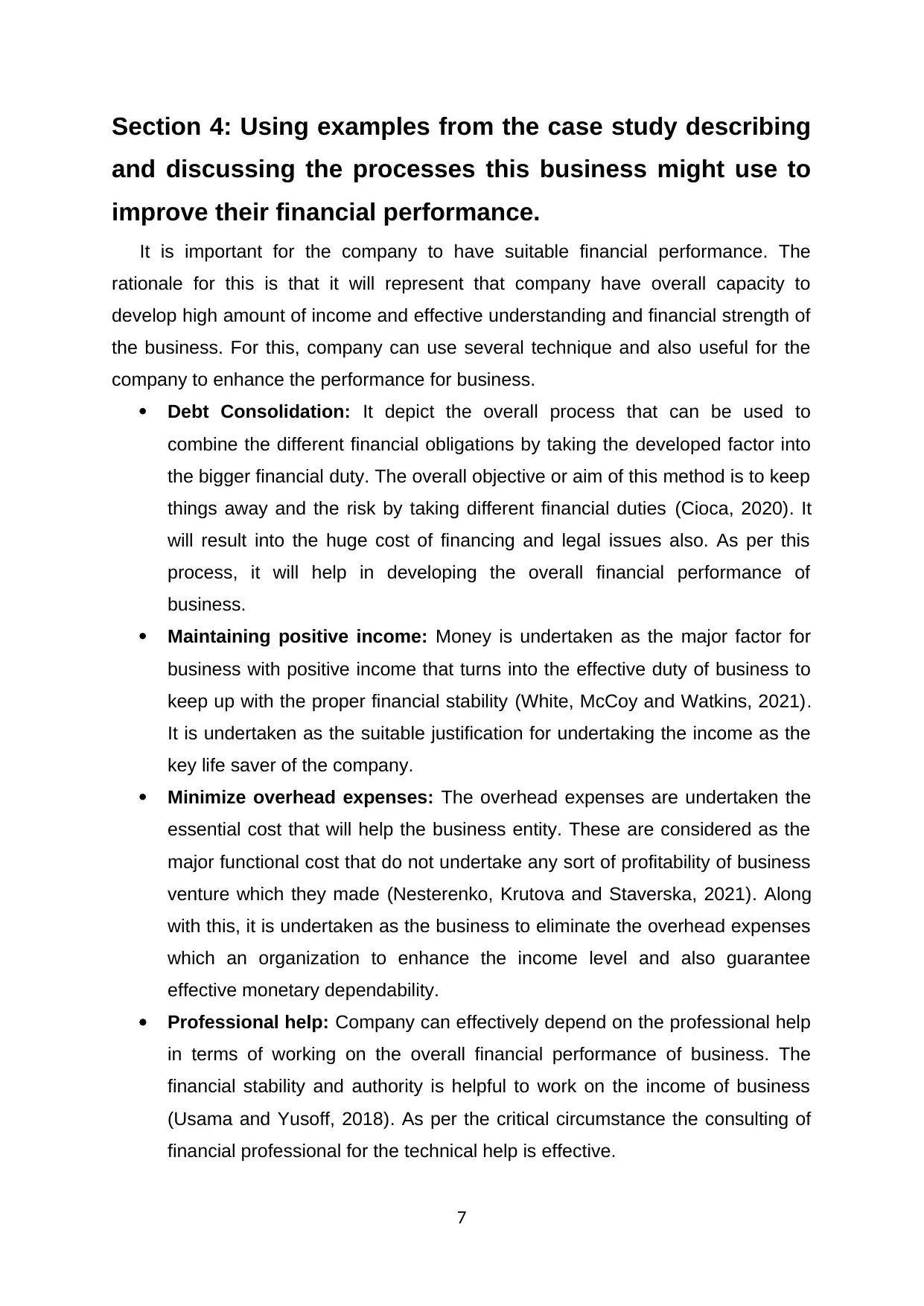
Section 4: Using examples from the case study describing
and discussing the processes this business might use to
improve their financial performance.
It is important for the company to have suitable financial performance. The
rationale for this is that it will represent that company have overall capacity to
develop high amount of income and effective understanding and financial strength of
the business. For this, company can use several technique and also useful for the
company to enhance the performance for business.
Debt Consolidation: It depict the overall process that can be used to
combine the different financial obligations by taking the developed factor into
the bigger financial duty. The overall objective or aim of this method is to keep
things away and the risk by taking different financial duties (Cioca, 2020). It
will result into the huge cost of financing and legal issues also. As per this
process, it will help in developing the overall financial performance of
business.
Maintaining positive income: Money is undertaken as the major factor for
business with positive income that turns into the effective duty of business to
keep up with the proper financial stability (White, McCoy and Watkins, 2021).
It is undertaken as the suitable justification for undertaking the income as the
key life saver of the company.
Minimize overhead expenses: The overhead expenses are undertaken the
essential cost that will help the business entity. These are considered as the
major functional cost that do not undertake any sort of profitability of business
venture which they made (Nesterenko, Krutova and Staverska, 2021). Along
with this, it is undertaken as the business to eliminate the overhead expenses
which an organization to enhance the income level and also guarantee
effective monetary dependability.
Professional help: Company can effectively depend on the professional help
in terms of working on the overall financial performance of business. The
financial stability and authority is helpful to work on the income of business
(Usama and Yusoff, 2018). As per the critical circumstance the consulting of
financial professional for the technical help is effective.
7
and discussing the processes this business might use to
improve their financial performance.
It is important for the company to have suitable financial performance. The
rationale for this is that it will represent that company have overall capacity to
develop high amount of income and effective understanding and financial strength of
the business. For this, company can use several technique and also useful for the
company to enhance the performance for business.
Debt Consolidation: It depict the overall process that can be used to
combine the different financial obligations by taking the developed factor into
the bigger financial duty. The overall objective or aim of this method is to keep
things away and the risk by taking different financial duties (Cioca, 2020). It
will result into the huge cost of financing and legal issues also. As per this
process, it will help in developing the overall financial performance of
business.
Maintaining positive income: Money is undertaken as the major factor for
business with positive income that turns into the effective duty of business to
keep up with the proper financial stability (White, McCoy and Watkins, 2021).
It is undertaken as the suitable justification for undertaking the income as the
key life saver of the company.
Minimize overhead expenses: The overhead expenses are undertaken the
essential cost that will help the business entity. These are considered as the
major functional cost that do not undertake any sort of profitability of business
venture which they made (Nesterenko, Krutova and Staverska, 2021). Along
with this, it is undertaken as the business to eliminate the overhead expenses
which an organization to enhance the income level and also guarantee
effective monetary dependability.
Professional help: Company can effectively depend on the professional help
in terms of working on the overall financial performance of business. The
financial stability and authority is helpful to work on the income of business
(Usama and Yusoff, 2018). As per the critical circumstance the consulting of
financial professional for the technical help is effective.
7
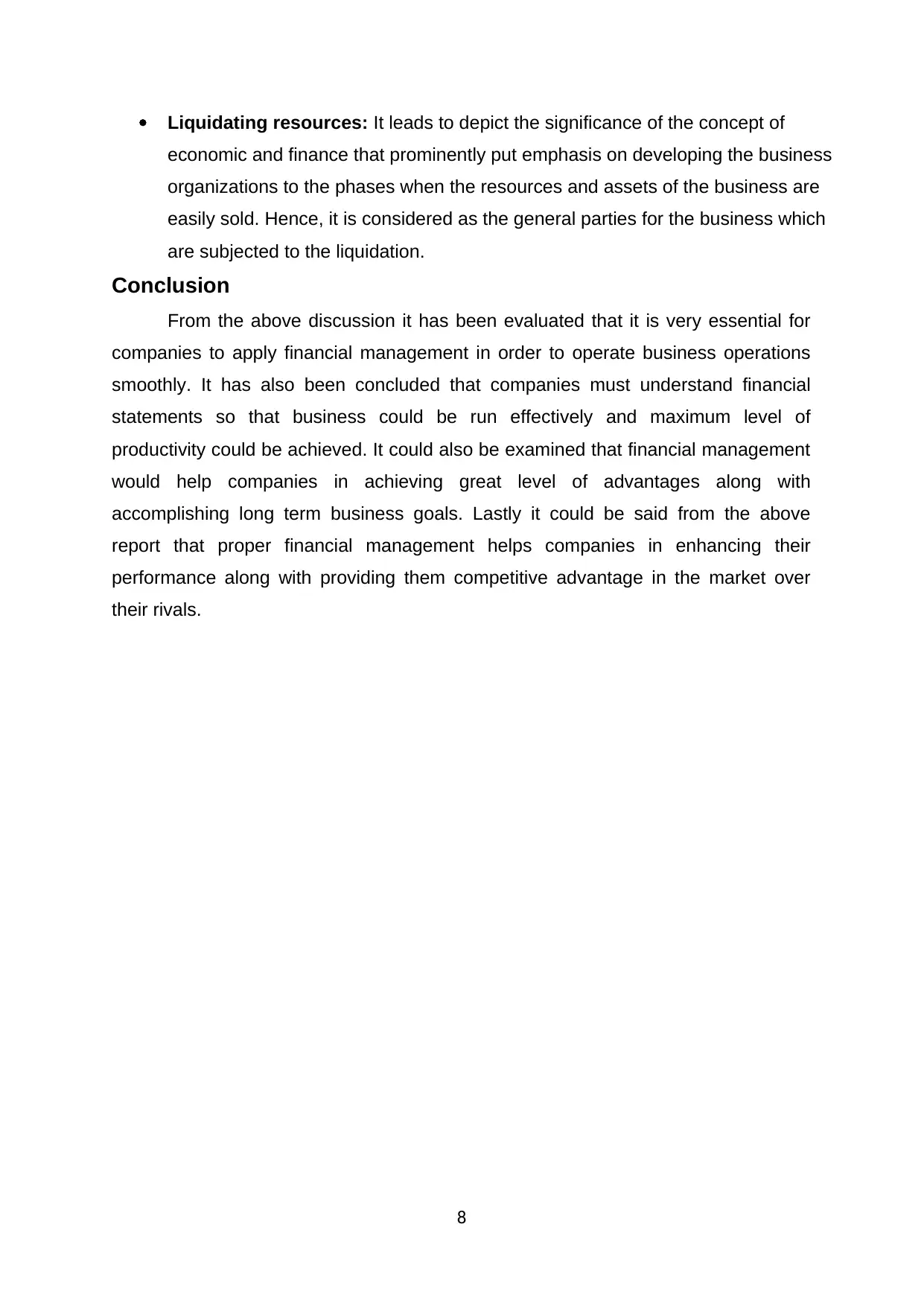
Liquidating resources: It leads to depict the significance of the concept of
economic and finance that prominently put emphasis on developing the business
organizations to the phases when the resources and assets of the business are
easily sold. Hence, it is considered as the general parties for the business which
are subjected to the liquidation.
Conclusion
From the above discussion it has been evaluated that it is very essential for
companies to apply financial management in order to operate business operations
smoothly. It has also been concluded that companies must understand financial
statements so that business could be run effectively and maximum level of
productivity could be achieved. It could also be examined that financial management
would help companies in achieving great level of advantages along with
accomplishing long term business goals. Lastly it could be said from the above
report that proper financial management helps companies in enhancing their
performance along with providing them competitive advantage in the market over
their rivals.
8
economic and finance that prominently put emphasis on developing the business
organizations to the phases when the resources and assets of the business are
easily sold. Hence, it is considered as the general parties for the business which
are subjected to the liquidation.
Conclusion
From the above discussion it has been evaluated that it is very essential for
companies to apply financial management in order to operate business operations
smoothly. It has also been concluded that companies must understand financial
statements so that business could be run effectively and maximum level of
productivity could be achieved. It could also be examined that financial management
would help companies in achieving great level of advantages along with
accomplishing long term business goals. Lastly it could be said from the above
report that proper financial management helps companies in enhancing their
performance along with providing them competitive advantage in the market over
their rivals.
8

References
Broyles, J., 2020. Financial management and real options.
Cioca, I.C., 2020. The Importance Of Financial Statements In The Decision-Making
Process. Annales Universitatis Apulensis Series Oeconomica, 1(22),
pp.73-83.
Jorge, S., de Jesus, M.A.J. and Nogueira, S.P., 2019. The use of budgetary and
financial information by politicians in parliament: a case study. Journal
of Public Budgeting, Accounting & Financial Management.
Lan, Y. and Li, X., 2021. A Brief Analysis of the Application of Enterprise’s Internal
Accounting and Financial Management in Computer. In E3S Web of
Conferences (Vol. 235). EDP Sciences.
Liu, H., 2020, April. Development Strategy Evaluation of Financial Information
Disclosure in Colleges and Universities Based on SWOT Method. In
Journal of Physics: Conference Series (Vol. 1533, No. 2, p. 022077).
IOP Publishing.
Nesterenko, O., Krutova, A. and Staverska, T., 2021. TRANSPARENCY OF
FINANCIAL REPORTING IN THE CONDITIONS OF MODERN
INFORMATION TECHNOLOGY. Research and Innovation, p.120.
Ukaigwe, P.C. and Igbozuruike, I.U., 2018. Education Law and Community
Participation in Financial Management of Secondary Schools in Rivers
State. Educational Research International, 7(3), pp.43-52.
Usama, K.M. and Yusoff, W.F.W., 2018. The relationship between entrepreneurs’
financial literacy and business performance among entrepreneurs of
Bauchi State Nigeria. International Journal of Entrepreneurship and
Business Innovation, 1(1), pp.15-26.
Veledar, B. and Letica, M., 2020, September. Challenges in Implementing the
Concept of Public Internal Financial Controls in the Public Sector of
Bosnia and Herzegovina. In Proceedings of the ENTRENOVA-
ENTerprise REsearch InNOVAtion Conference (Online) (Vol. 6, No. 1,
pp. 187-194).
White, K.J., McCoy, M. and Watkins, K., 2021. Resource Management:
Environmental Sustainability Across the Financial Literacy Curriculum.
Journal of Family & Consumer Sciences Education, 38(1).
Xu, H., 2019. Analysis of Enterprise Financial Management Innovation Under the
Background of “Internet+” Industry Convergence.
Zhang, M., 2020, December. Exploration of the Digital Transformation of Traditional
Enterprise Financial Management under the Background of Big Data. In
2020 International Conference on Big Data Economy and Information
Management (BDEIM) (pp. 5-8). IEEE.
9
Broyles, J., 2020. Financial management and real options.
Cioca, I.C., 2020. The Importance Of Financial Statements In The Decision-Making
Process. Annales Universitatis Apulensis Series Oeconomica, 1(22),
pp.73-83.
Jorge, S., de Jesus, M.A.J. and Nogueira, S.P., 2019. The use of budgetary and
financial information by politicians in parliament: a case study. Journal
of Public Budgeting, Accounting & Financial Management.
Lan, Y. and Li, X., 2021. A Brief Analysis of the Application of Enterprise’s Internal
Accounting and Financial Management in Computer. In E3S Web of
Conferences (Vol. 235). EDP Sciences.
Liu, H., 2020, April. Development Strategy Evaluation of Financial Information
Disclosure in Colleges and Universities Based on SWOT Method. In
Journal of Physics: Conference Series (Vol. 1533, No. 2, p. 022077).
IOP Publishing.
Nesterenko, O., Krutova, A. and Staverska, T., 2021. TRANSPARENCY OF
FINANCIAL REPORTING IN THE CONDITIONS OF MODERN
INFORMATION TECHNOLOGY. Research and Innovation, p.120.
Ukaigwe, P.C. and Igbozuruike, I.U., 2018. Education Law and Community
Participation in Financial Management of Secondary Schools in Rivers
State. Educational Research International, 7(3), pp.43-52.
Usama, K.M. and Yusoff, W.F.W., 2018. The relationship between entrepreneurs’
financial literacy and business performance among entrepreneurs of
Bauchi State Nigeria. International Journal of Entrepreneurship and
Business Innovation, 1(1), pp.15-26.
Veledar, B. and Letica, M., 2020, September. Challenges in Implementing the
Concept of Public Internal Financial Controls in the Public Sector of
Bosnia and Herzegovina. In Proceedings of the ENTRENOVA-
ENTerprise REsearch InNOVAtion Conference (Online) (Vol. 6, No. 1,
pp. 187-194).
White, K.J., McCoy, M. and Watkins, K., 2021. Resource Management:
Environmental Sustainability Across the Financial Literacy Curriculum.
Journal of Family & Consumer Sciences Education, 38(1).
Xu, H., 2019. Analysis of Enterprise Financial Management Innovation Under the
Background of “Internet+” Industry Convergence.
Zhang, M., 2020, December. Exploration of the Digital Transformation of Traditional
Enterprise Financial Management under the Background of Big Data. In
2020 International Conference on Big Data Economy and Information
Management (BDEIM) (pp. 5-8). IEEE.
9
Secure Best Marks with AI Grader
Need help grading? Try our AI Grader for instant feedback on your assignments.
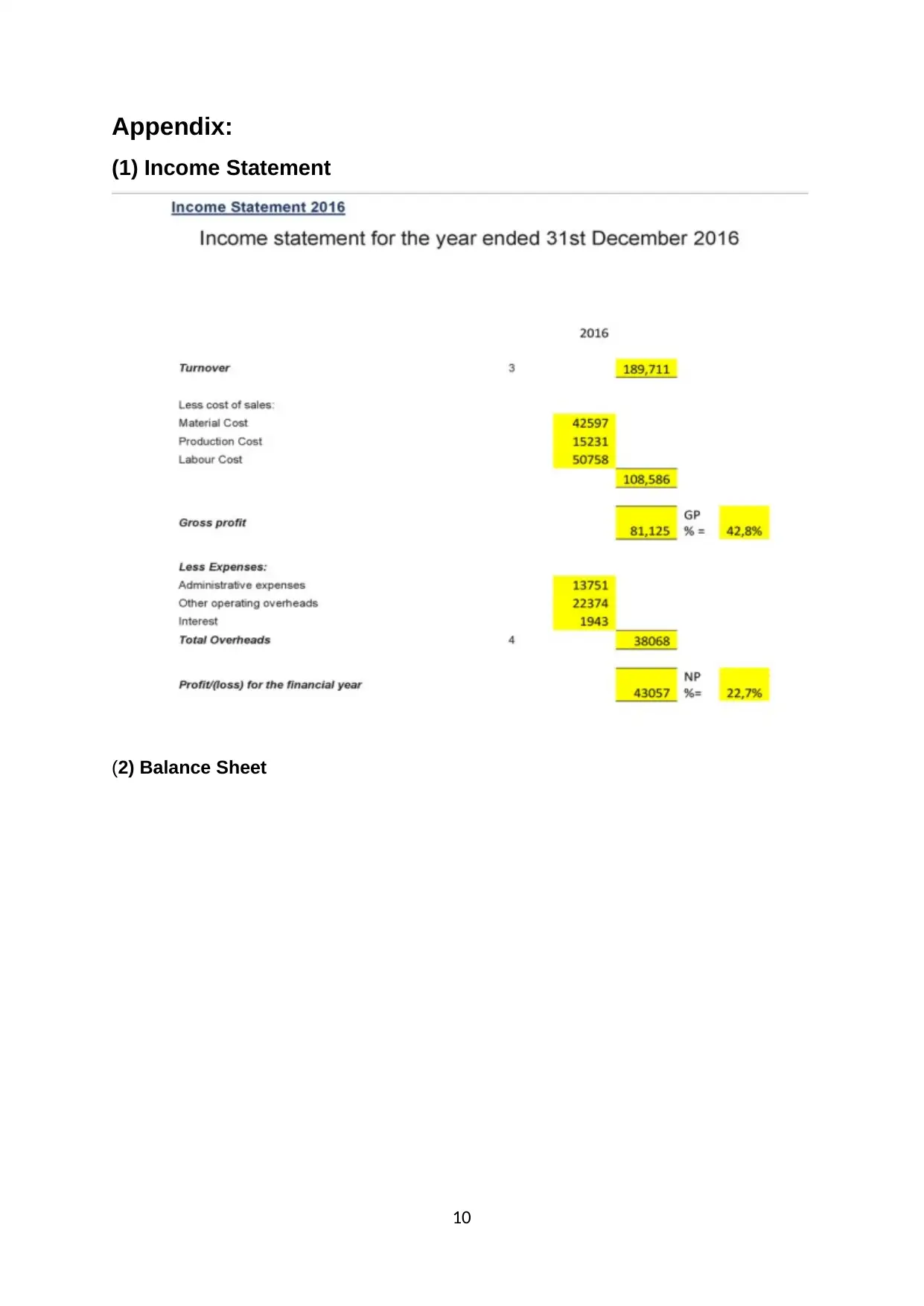
Appendix:
(1) Income Statement
(2) Balance Sheet
10
(1) Income Statement
(2) Balance Sheet
10
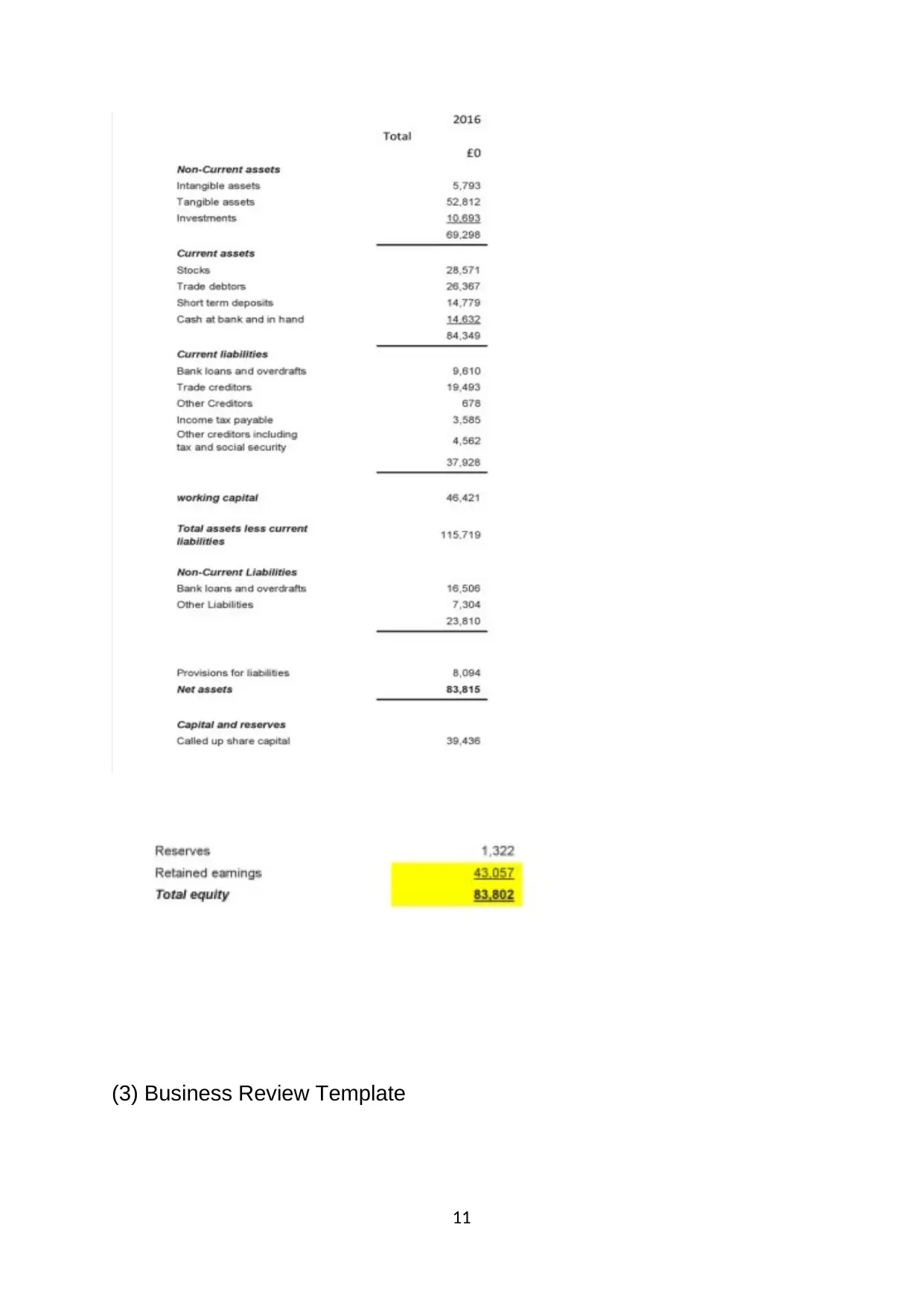
(3) Business Review Template
11
11
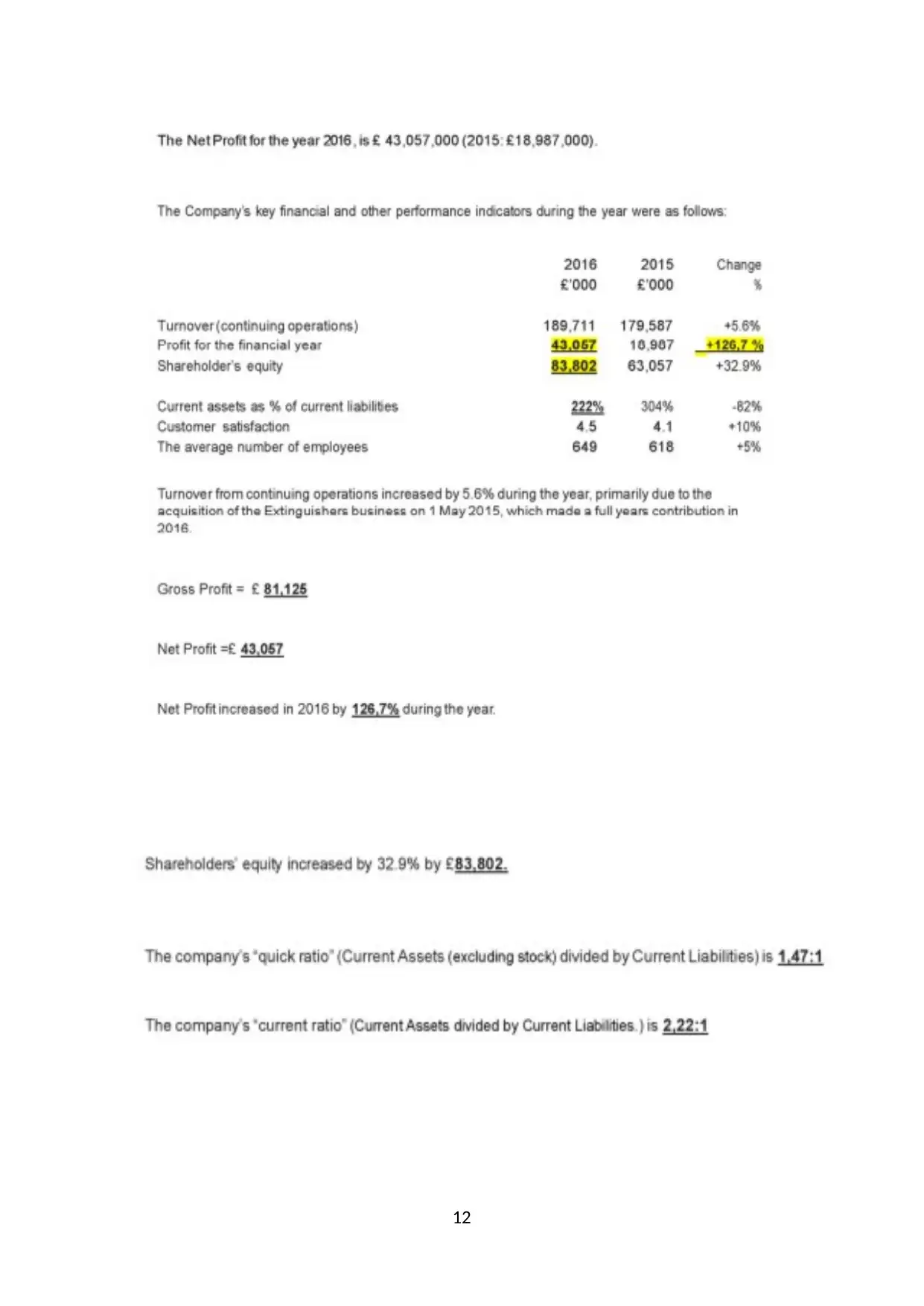
12
Paraphrase This Document
Need a fresh take? Get an instant paraphrase of this document with our AI Paraphraser

Calculations
13
13
1 out of 14
Related Documents
Your All-in-One AI-Powered Toolkit for Academic Success.
+13062052269
info@desklib.com
Available 24*7 on WhatsApp / Email
![[object Object]](/_next/static/media/star-bottom.7253800d.svg)
Unlock your academic potential
© 2024 | Zucol Services PVT LTD | All rights reserved.

